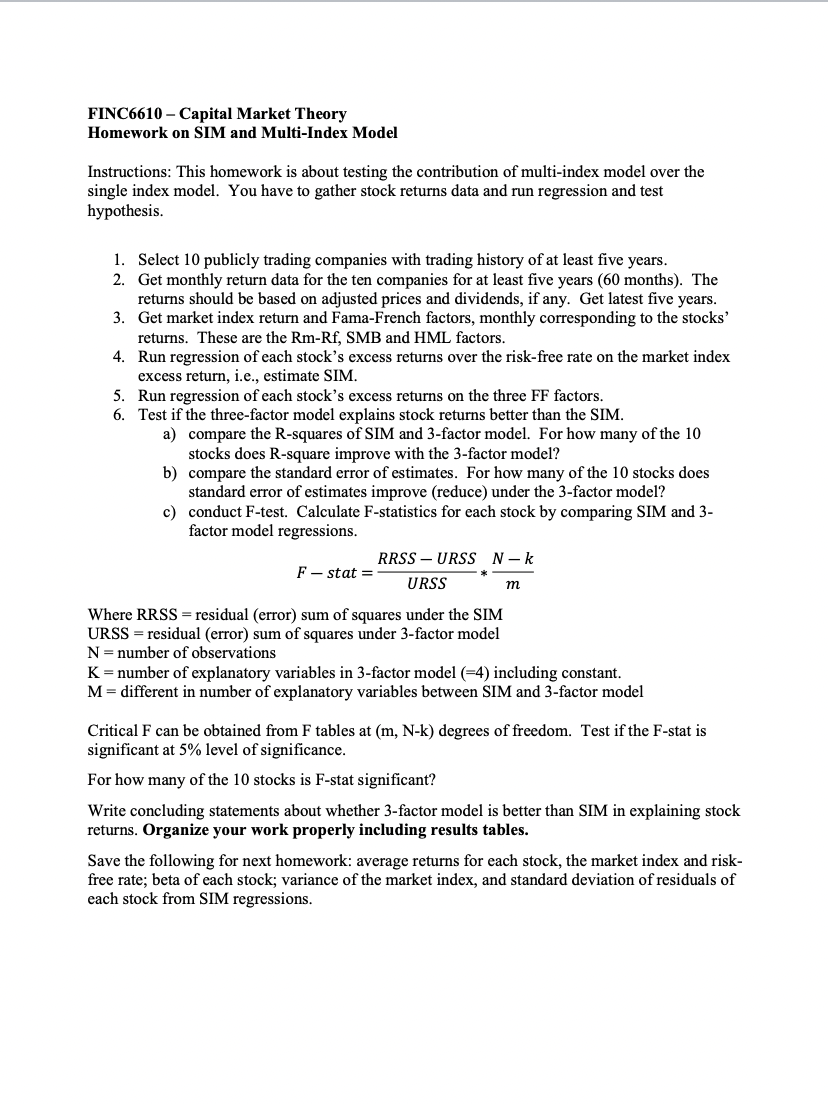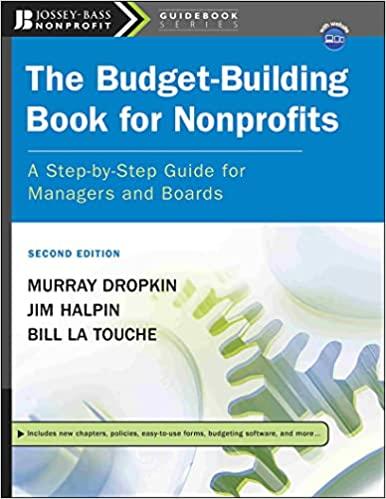
FINC6610 - Capital Market Theory Homework on SIM and Multi-Index Model Instructions: This homework is about testing the contribution of multi-index model over the single index model. You have to gather stock returns data and run regression and test hypothesis. 1. Select 10 publicly trading companies with trading history of at least five years. 2. Get monthly return data for the ten companies for at least five years (60 months). The returns should be based on adjusted prices and dividends, if any. Get latest five years. 3. Get market index return and Fama-French factors, monthly corresponding to the stocks' returns. These are the Rm-Rf, SMB and HML factors. 4. Run regression of each stock's excess returns over the risk-free rate on the market index excess return, i.e., estimate SIM. 5. Run regression of each stock's excess returns on the three FF factors. 6. Test if the three-factor model explains stock returns better than the SIM. a) compare the R-squares of SIM and 3-factor model. For how many of the 10 stocks does R-square improve with the 3-factor model? b) compare the standard error of estimates. For how many of the 10 stocks does standard error of estimates improve (reduce) under the 3-factor model? c) conduct F-test. Calculate F-statistics for each stock by comparing SIM and 3- factor model regressions. RRSS - URSS N - k F-stat = URSS Where RRSS = residual (error) sum of squares under the SIM URSS = residual (error) sum of squares under 3-factor model N=number of observations K= number of explanatory variables in 3-factor model (=4) including constant. M= different in number of explanatory variables between SIM and 3-factor model m Critical F can be obtained from F tables at (m, N-k) degrees of freedom. Test if the F-stat is significant at 5% level of significance. For how many of the 10 stocks is F-stat significant? Write concluding statements about whether 3-factor model is better than SIM in explaining stock returns. Organize your work properly including results tables. Save the following for next homework: average returns for each stock, the market index and risk- free rate; beta of each stock; variance of the market index, and standard deviation of residuals of each stock from SIM regressions. FINC6610 - Capital Market Theory Homework on SIM and Multi-Index Model Instructions: This homework is about testing the contribution of multi-index model over the single index model. You have to gather stock returns data and run regression and test hypothesis. 1. Select 10 publicly trading companies with trading history of at least five years. 2. Get monthly return data for the ten companies for at least five years (60 months). The returns should be based on adjusted prices and dividends, if any. Get latest five years. 3. Get market index return and Fama-French factors, monthly corresponding to the stocks' returns. These are the Rm-Rf, SMB and HML factors. 4. Run regression of each stock's excess returns over the risk-free rate on the market index excess return, i.e., estimate SIM. 5. Run regression of each stock's excess returns on the three FF factors. 6. Test if the three-factor model explains stock returns better than the SIM. a) compare the R-squares of SIM and 3-factor model. For how many of the 10 stocks does R-square improve with the 3-factor model? b) compare the standard error of estimates. For how many of the 10 stocks does standard error of estimates improve (reduce) under the 3-factor model? c) conduct F-test. Calculate F-statistics for each stock by comparing SIM and 3- factor model regressions. RRSS - URSS N - k F-stat = URSS Where RRSS = residual (error) sum of squares under the SIM URSS = residual (error) sum of squares under 3-factor model N=number of observations K= number of explanatory variables in 3-factor model (=4) including constant. M= different in number of explanatory variables between SIM and 3-factor model m Critical F can be obtained from F tables at (m, N-k) degrees of freedom. Test if the F-stat is significant at 5% level of significance. For how many of the 10 stocks is F-stat significant? Write concluding statements about whether 3-factor model is better than SIM in explaining stock returns. Organize your work properly including results tables. Save the following for next homework: average returns for each stock, the market index and risk- free rate; beta of each stock; variance of the market index, and standard deviation of residuals of each stock from SIM regressions







